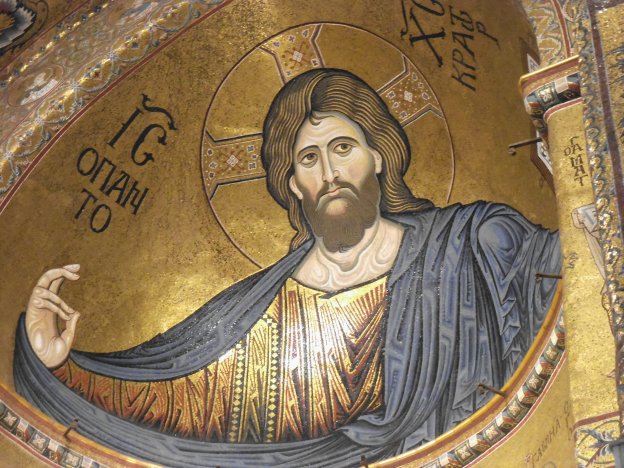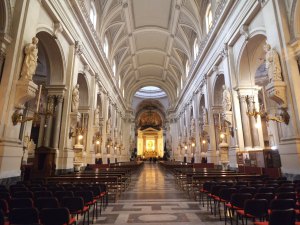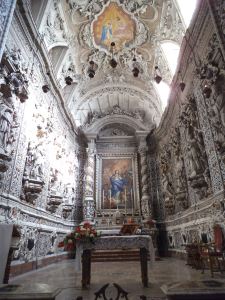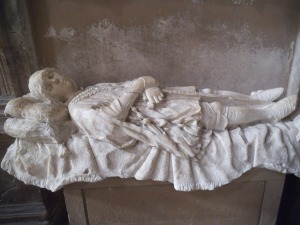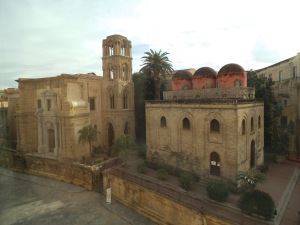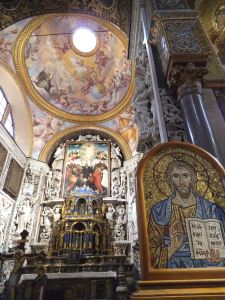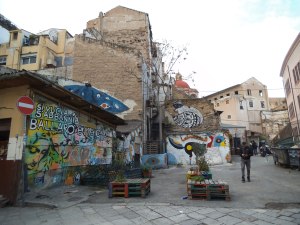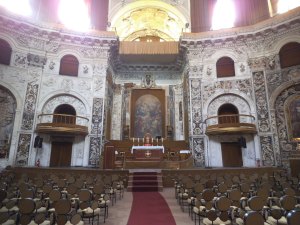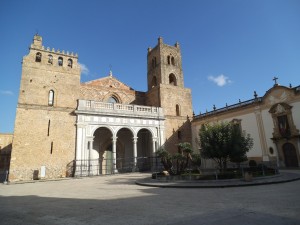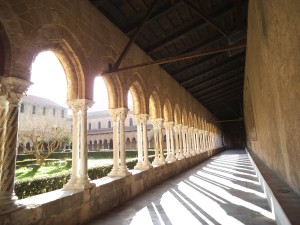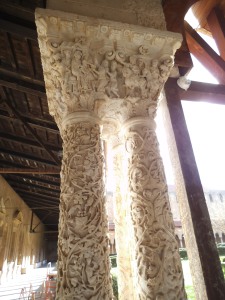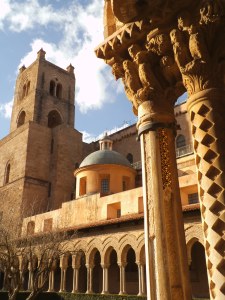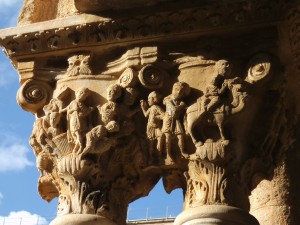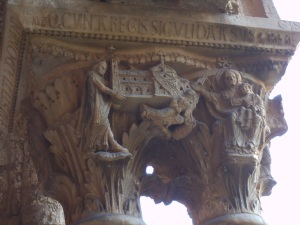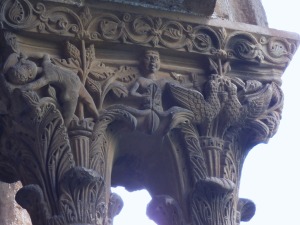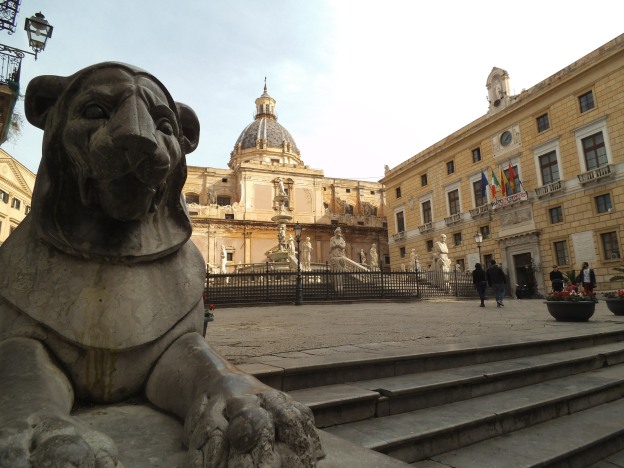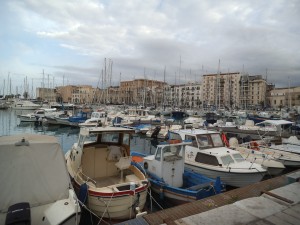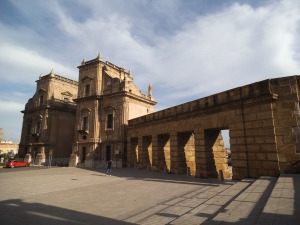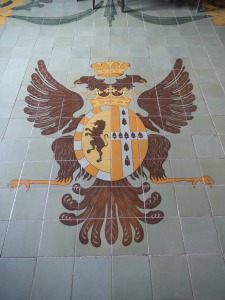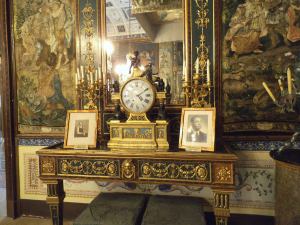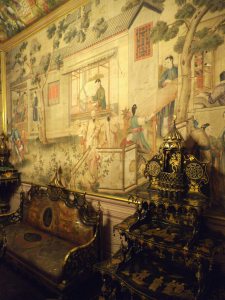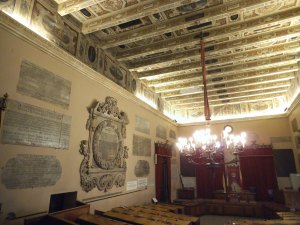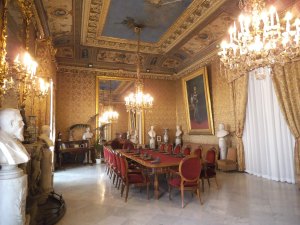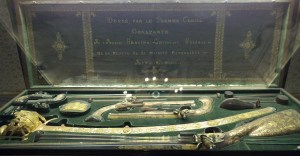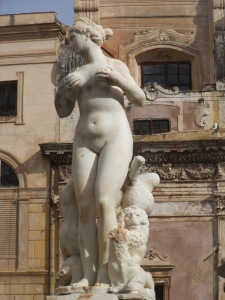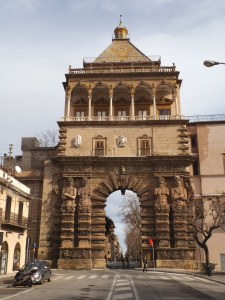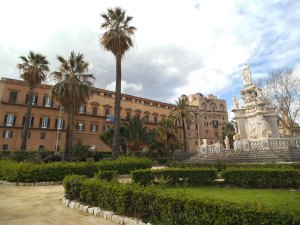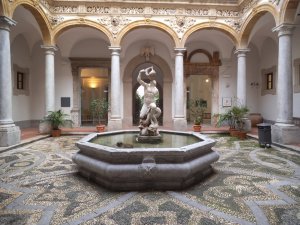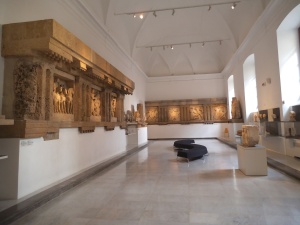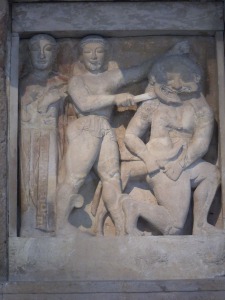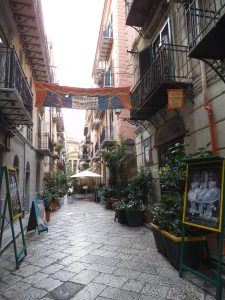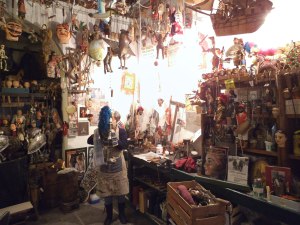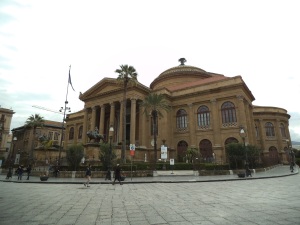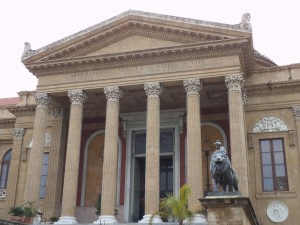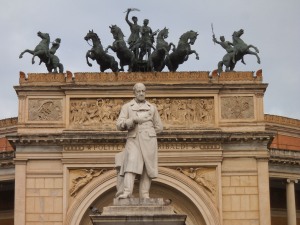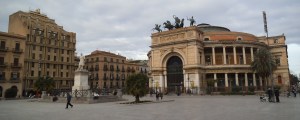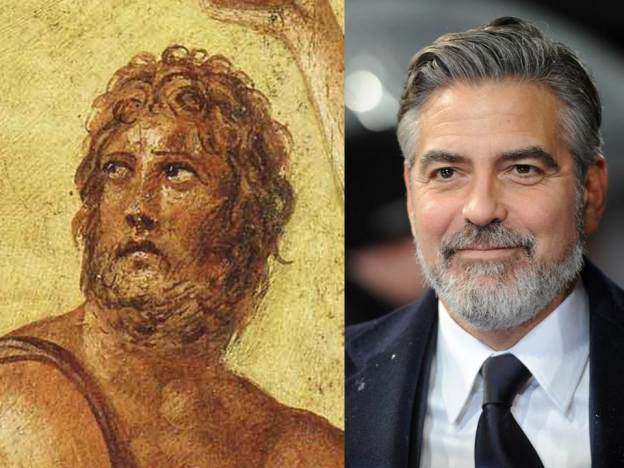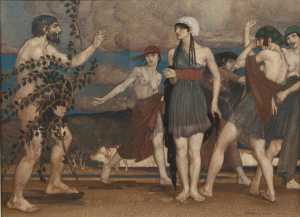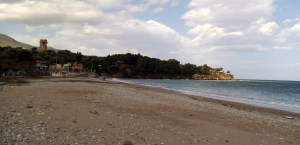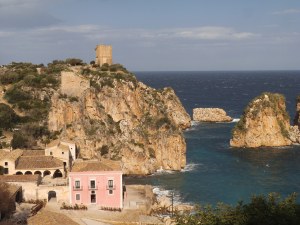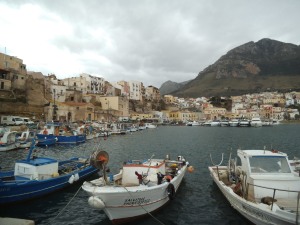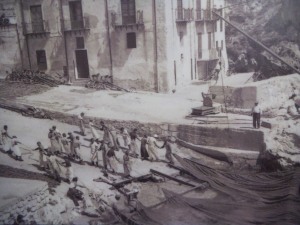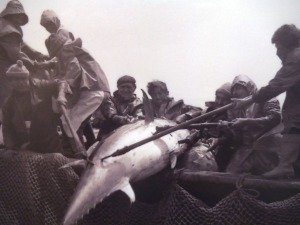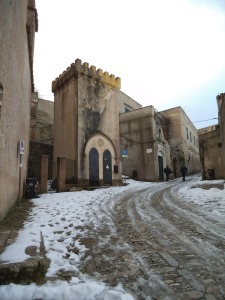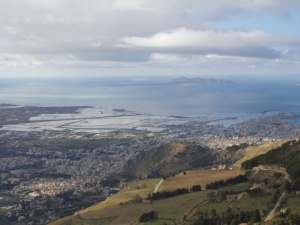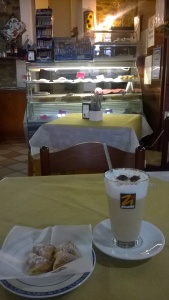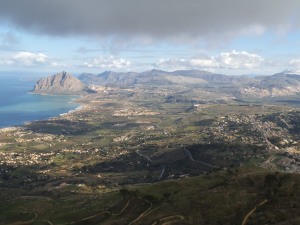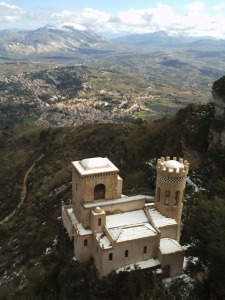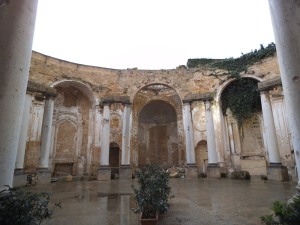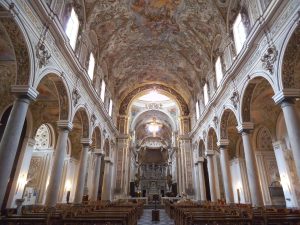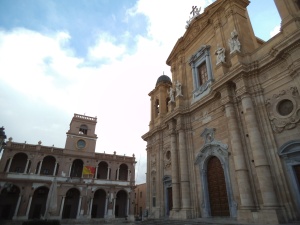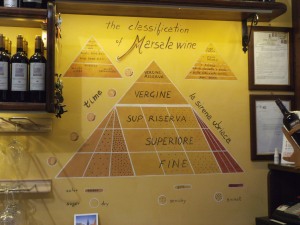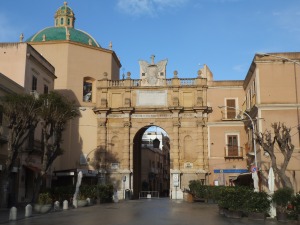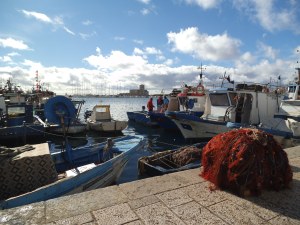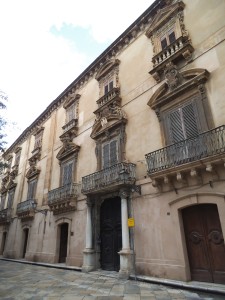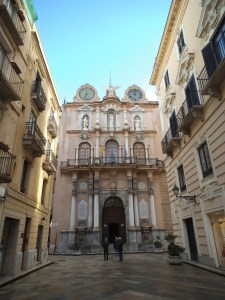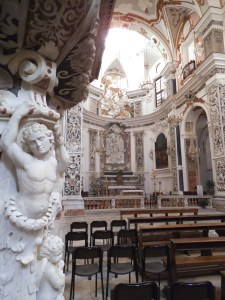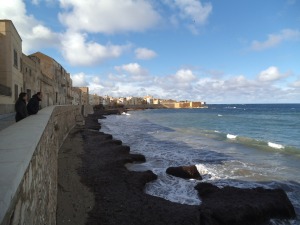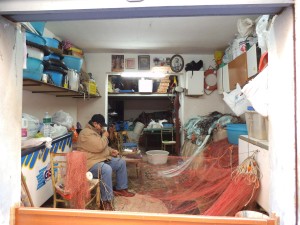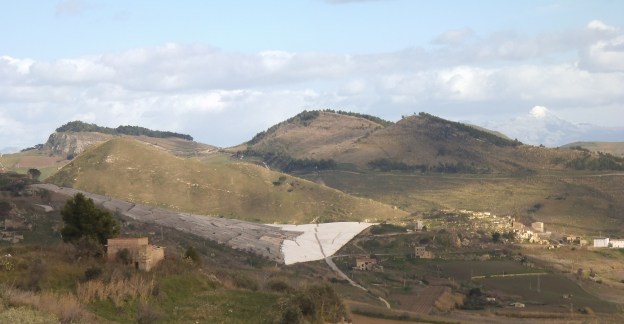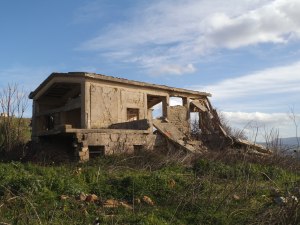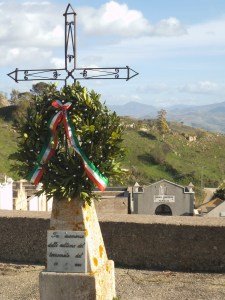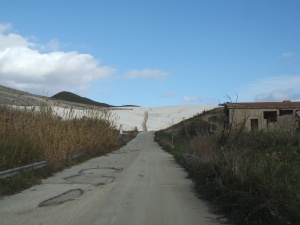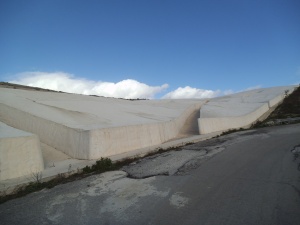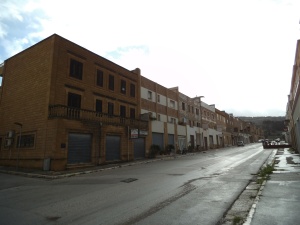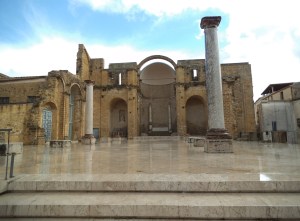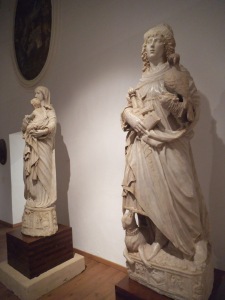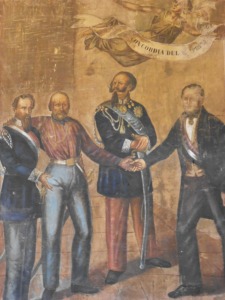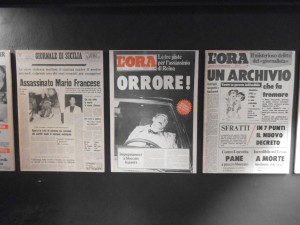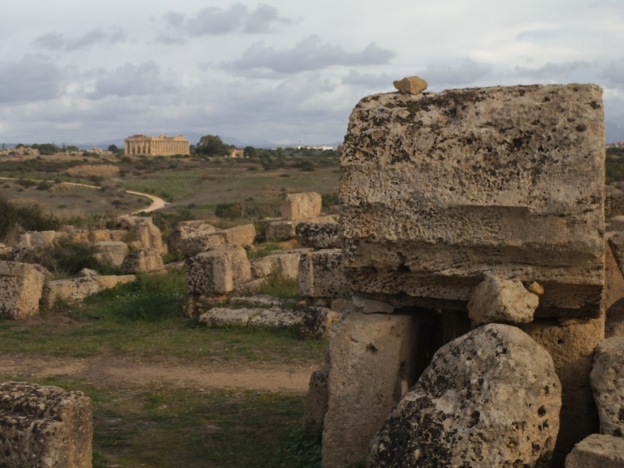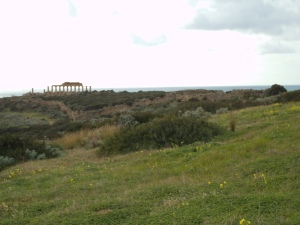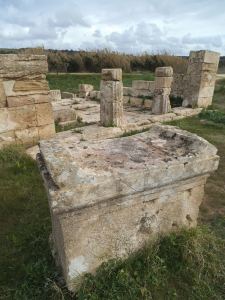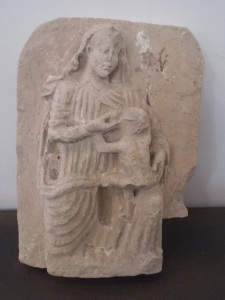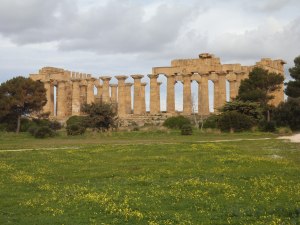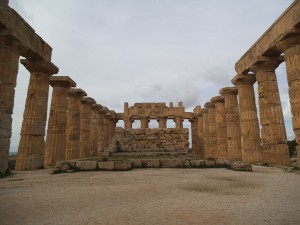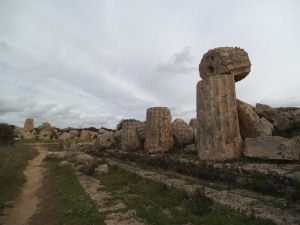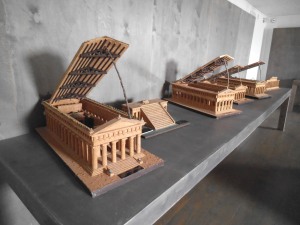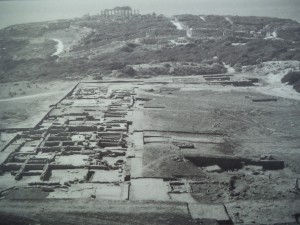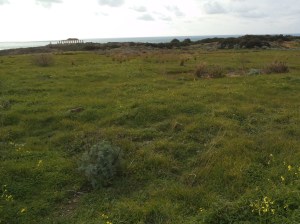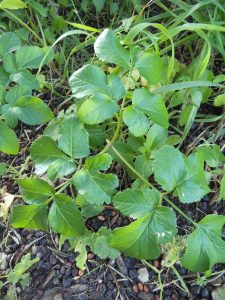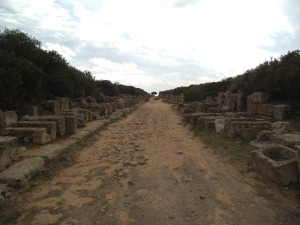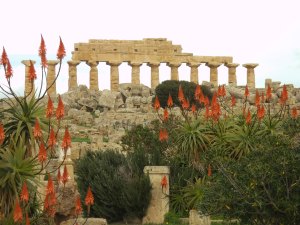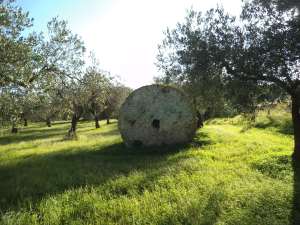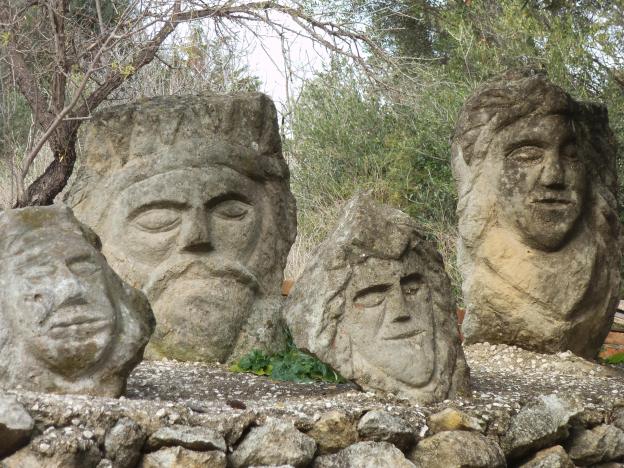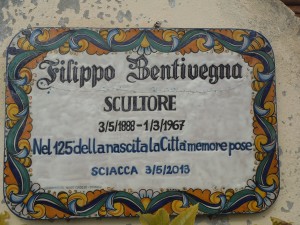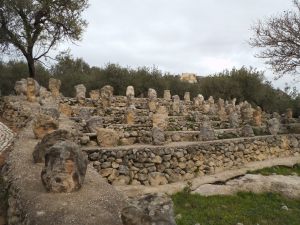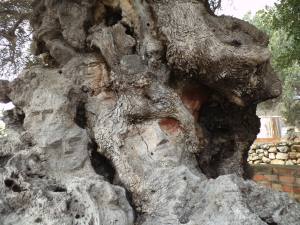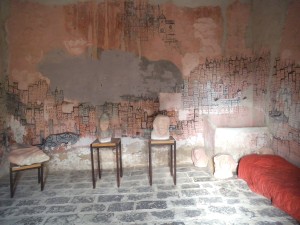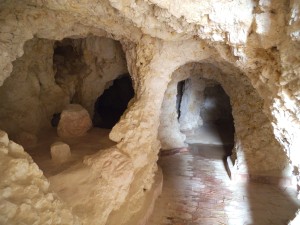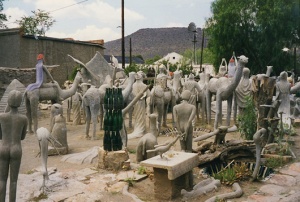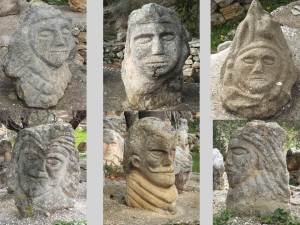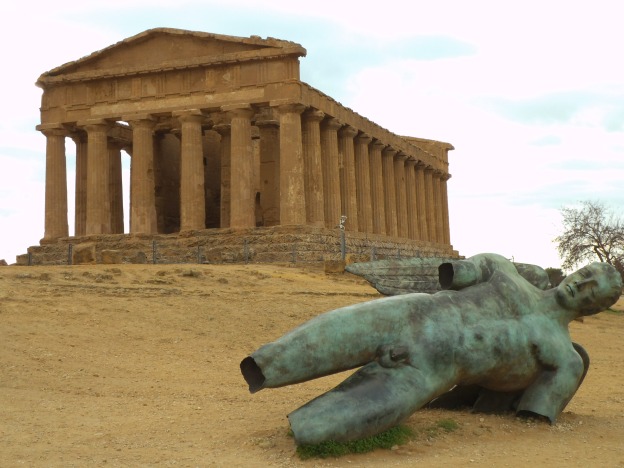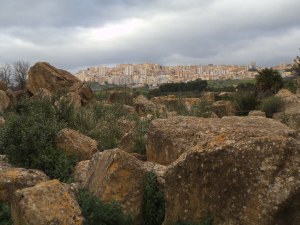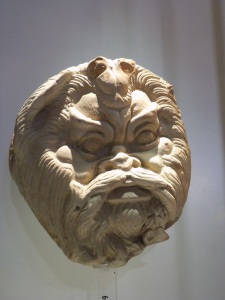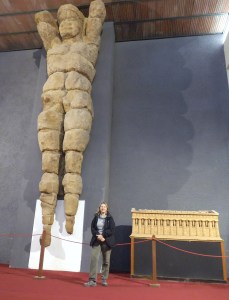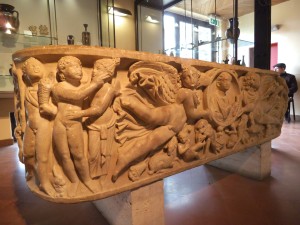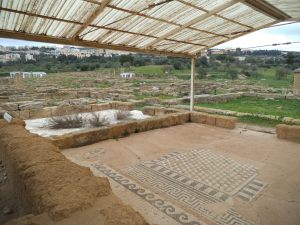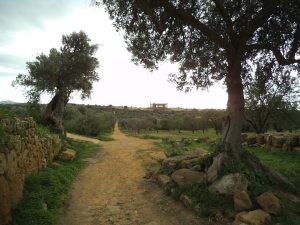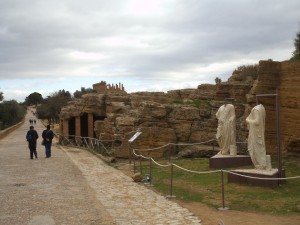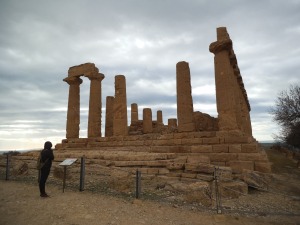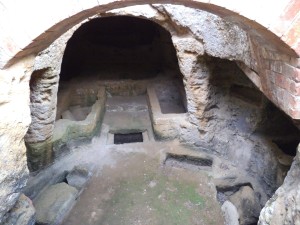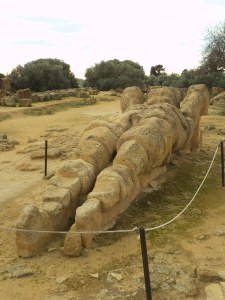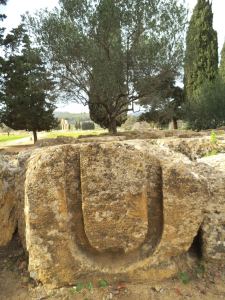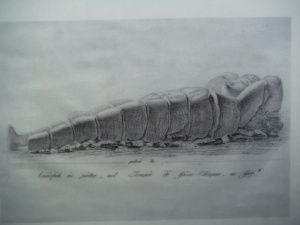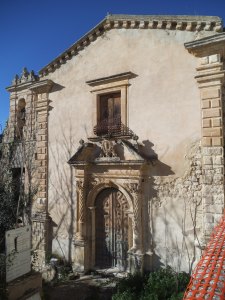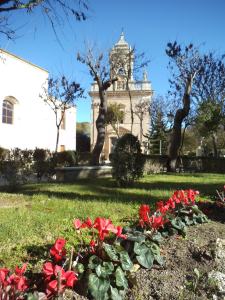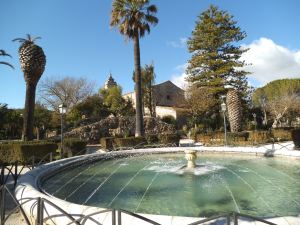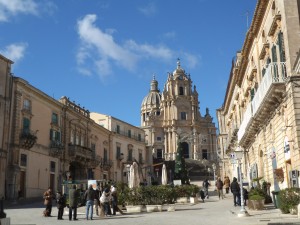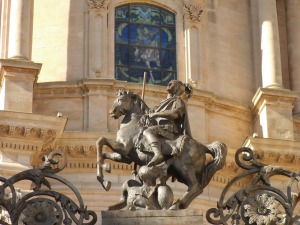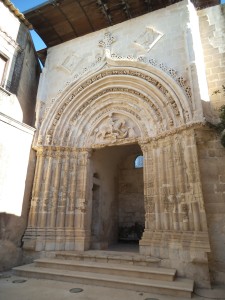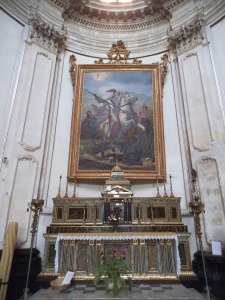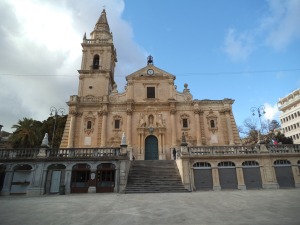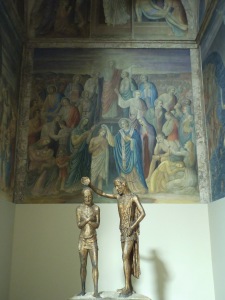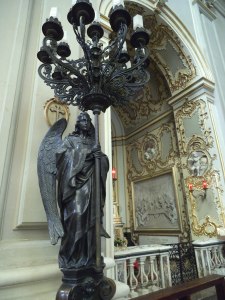 As I’ve mentioned many times before, I’m not a religious person but I do find it hard to pass a church without popping inside. I’m drawn by the amazing architecture and interior decoration that I usually find within, as well as the opportunity for a moment of peace in what is sometimes a busy town or city.
As I’ve mentioned many times before, I’m not a religious person but I do find it hard to pass a church without popping inside. I’m drawn by the amazing architecture and interior decoration that I usually find within, as well as the opportunity for a moment of peace in what is sometimes a busy town or city.
Most people who visit Palermo will find themselves at the Cathedral. The exterior is a beautiful mish-mash of styles; Norman arches, Gothic turrets and Baroque capitals. However, the interior is a disappointment. The Royal Tombs are screened off and inaccessible without paying a fee and the chapels are rather plain.
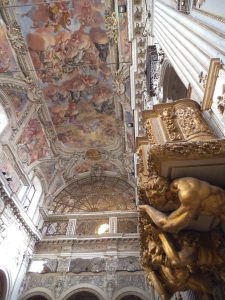 Luckily, there are plenty of other churches in the city and, although they may not be as grand in scale, they are actually a lot more interesting and beautiful. The first church I find near to La Cala, in an area that was mostly destroyed by WWII bombing. Santa Maria della Pieta has a very theatrical feel – red curtains, and gold wooden boxes topped with organ pipes.
Luckily, there are plenty of other churches in the city and, although they may not be as grand in scale, they are actually a lot more interesting and beautiful. The first church I find near to La Cala, in an area that was mostly destroyed by WWII bombing. Santa Maria della Pieta has a very theatrical feel – red curtains, and gold wooden boxes topped with organ pipes.
I only have 5 minutes to see the Church of San Francesco d’Assisi as the guardian is about to lock up but he patiently waits while I wander and examine the exquisitely carved marble apse and a marble tomb by Domenico Gagini that seems so lifelike that I half expect the occupant to wake up and wander off.
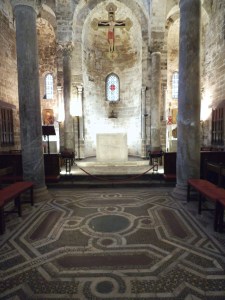 Probably one of the most visited churches in Palermo is also one of the smallest. The 12th century San Cataldo was built by Maione di Bari using Arab labour, hence the Arabic influenced décor in the windows and the domes on the roof. There is also a lovely mosaic floor and it is a very peaceful place. Bizarrely, during the 18th century it was deconsecrated and used as a post office.
Probably one of the most visited churches in Palermo is also one of the smallest. The 12th century San Cataldo was built by Maione di Bari using Arab labour, hence the Arabic influenced décor in the windows and the domes on the roof. There is also a lovely mosaic floor and it is a very peaceful place. Bizarrely, during the 18th century it was deconsecrated and used as a post office.
 Next door is the 12th century La Martorana, so called because Eloisa della Martorana, who founded the nearby convent, used to decorate the church with marzipan fruits which are still a local Palermo treat. The ceilings are covered with a mixture of golden mosaics and Baroque frescos but somehow the two complement each other and it is one of the most beautiful churches that I have ever visited, and I’ve seen quite a lot.
Next door is the 12th century La Martorana, so called because Eloisa della Martorana, who founded the nearby convent, used to decorate the church with marzipan fruits which are still a local Palermo treat. The ceilings are covered with a mixture of golden mosaics and Baroque frescos but somehow the two complement each other and it is one of the most beautiful churches that I have ever visited, and I’ve seen quite a lot.
 I want to visit the church of San Nicolo which is advertised as having a 13th century watchtower offering some of the best views of the city. Even though I am not far from the Cathedral, I find myself in the Albergheria, the oldest and now the poorest area of Palermo. The streets are full of graffiti, dripping laundry, abandoned broken toys and immigrant youths. Changing direction, I duck into the 17th century Il Gesu, also known as Casa Professa. Founded by the Jesuits, it took more than 100 years to complete and was later badly damaged in WWII. However, the church was lovingly restored to its former Baroque splendour and even featured in the 1963 film Il Gattopardo (The Leopard), based on the book by Tomasi di Lampedusa.
I want to visit the church of San Nicolo which is advertised as having a 13th century watchtower offering some of the best views of the city. Even though I am not far from the Cathedral, I find myself in the Albergheria, the oldest and now the poorest area of Palermo. The streets are full of graffiti, dripping laundry, abandoned broken toys and immigrant youths. Changing direction, I duck into the 17th century Il Gesu, also known as Casa Professa. Founded by the Jesuits, it took more than 100 years to complete and was later badly damaged in WWII. However, the church was lovingly restored to its former Baroque splendour and even featured in the 1963 film Il Gattopardo (The Leopard), based on the book by Tomasi di Lampedusa.
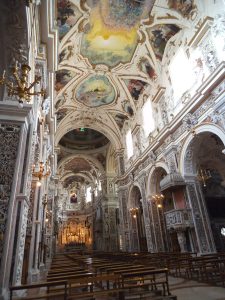
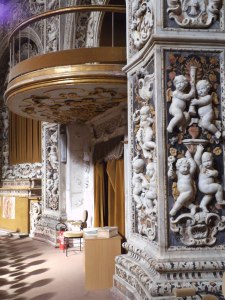 San Salvatore church, on the main thoroughfare of Corso Vittorio Emanuele, is an unusual shape, almost completely circular. The original church was founded in 1071 by Robert Guiscard as a convent for Basilian nuns. In 1682 the nuns decided that they needed a new structure and the present elliptical design was proposed by architect Paolo Amato. Like many other buildings in Palermo, the church suffered severe damage during WWII causing the collapse of the dome but it was restored and found a new use as a concert hall.
San Salvatore church, on the main thoroughfare of Corso Vittorio Emanuele, is an unusual shape, almost completely circular. The original church was founded in 1071 by Robert Guiscard as a convent for Basilian nuns. In 1682 the nuns decided that they needed a new structure and the present elliptical design was proposed by architect Paolo Amato. Like many other buildings in Palermo, the church suffered severe damage during WWII causing the collapse of the dome but it was restored and found a new use as a concert hall.
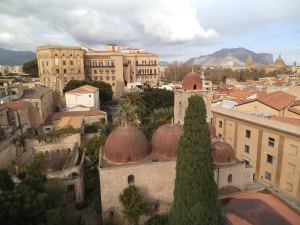 I decide against visiting the Palatine Chapel in the Palazzo Normani due to the extortionate entrance fee but, just around the corner, I stumble upon the church of San Giorgio di Kemonia which is frustratingly closed. However, for €2 I can climb the tower for a proposed view of the city. I’m given a hard hat to wear before I set off and, at first as I climb the interior stairs, I wonder why, but when I reach the spiral metal staircase which is loosely fixed within the tower, all becomes clear, as does the vista. The tower is not that high but it does offer a great view across to the Palazzo Normanni, the Cathedral and Monte Pellegrino in the distance. I can also see down to the red domed roof of the 12th century church of San Gregorio degli Ermiti and the charming little cloister in the garden.
I decide against visiting the Palatine Chapel in the Palazzo Normani due to the extortionate entrance fee but, just around the corner, I stumble upon the church of San Giorgio di Kemonia which is frustratingly closed. However, for €2 I can climb the tower for a proposed view of the city. I’m given a hard hat to wear before I set off and, at first as I climb the interior stairs, I wonder why, but when I reach the spiral metal staircase which is loosely fixed within the tower, all becomes clear, as does the vista. The tower is not that high but it does offer a great view across to the Palazzo Normanni, the Cathedral and Monte Pellegrino in the distance. I can also see down to the red domed roof of the 12th century church of San Gregorio degli Ermiti and the charming little cloister in the garden.
Monreale
8kms from Palermo, in the foothills to the south, is the town of Monreale (Royal Mountain). The cathedral and adjoining monastery were endowed by King William II in 1174 and he employed some of the best craftsmen to build and decorate them.
 Having already seen the marvellous mosaics of the churches in Ravenna, I have a good idea of what to expect from the Duomo of Monreale. However, what I really find distinctive about the mosaics in this cathedral is their ability to tell a story. The bible has literally been lifted from the page onto the walls and ceilings. It’s easy to appreciate God creating the earth, then Adam and Eve, Cain killing his brother Abel, Abraham about to sacrifice his son and Noah leading the animals onto and then off of the ark. The New Testament is also featured and Christ stands proudly in the central Apse, arms outstretched in a welcoming posture.
Having already seen the marvellous mosaics of the churches in Ravenna, I have a good idea of what to expect from the Duomo of Monreale. However, what I really find distinctive about the mosaics in this cathedral is their ability to tell a story. The bible has literally been lifted from the page onto the walls and ceilings. It’s easy to appreciate God creating the earth, then Adam and Eve, Cain killing his brother Abel, Abraham about to sacrifice his son and Noah leading the animals onto and then off of the ark. The New Testament is also featured and Christ stands proudly in the central Apse, arms outstretched in a welcoming posture.
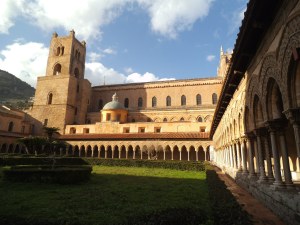 In a side chapel I find the tombs of William I and William II, and beyond are the cloisters, accessed through and external doorway off the piazza. More than 200 columns with intricately carved capitals surround the open courtyard. Again, they tell biblical stories, illustrate battles and depict other historical events, such as William II giving the church to the Virgin Mary. Some feature tradesmen, others depict animals, both real and mythical, and a few are rather sexual in nature. I’ve seen several beautiful cloisters in my travels but this is one of the best and I spent almost an hour in the tranquil space examining the capitals, amazed at the artistic skill of the men who produced them more than 800 years ago.
In a side chapel I find the tombs of William I and William II, and beyond are the cloisters, accessed through and external doorway off the piazza. More than 200 columns with intricately carved capitals surround the open courtyard. Again, they tell biblical stories, illustrate battles and depict other historical events, such as William II giving the church to the Virgin Mary. Some feature tradesmen, others depict animals, both real and mythical, and a few are rather sexual in nature. I’ve seen several beautiful cloisters in my travels but this is one of the best and I spent almost an hour in the tranquil space examining the capitals, amazed at the artistic skill of the men who produced them more than 800 years ago.

